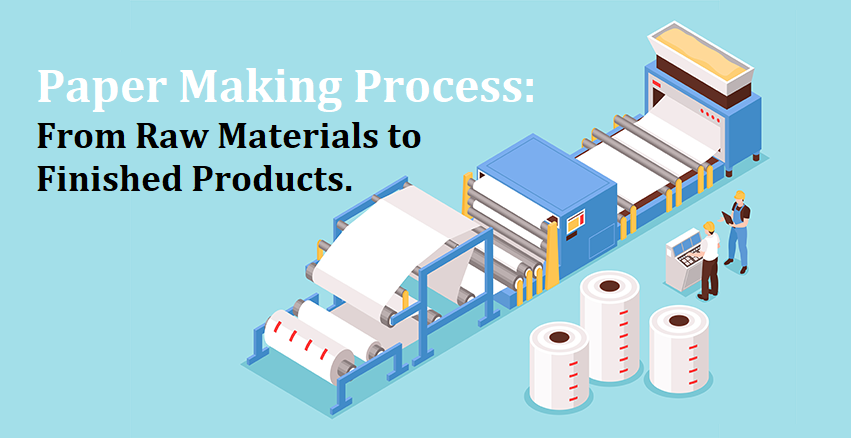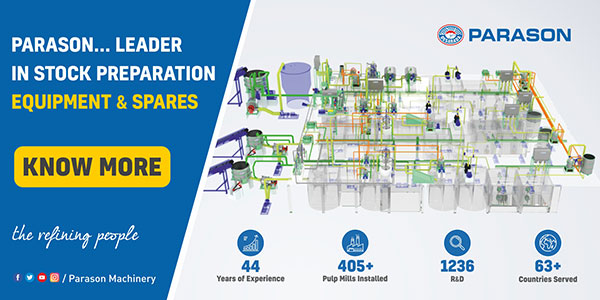The present-time paper-making process follows the fundamental principles that people have used for centuries, such as stock preparation, sheet formation, press sections, and drying. Although researchers have done many significant research and developments in this process to fulfill environmental and economic requirements for the past two centuries.
In this article, we will go through the modern paper-making process from Raw material to the Final stage using mechanical pulping.
In the process of making paper, manufacturers treat raw materials like wood fiber and recycled fiber mechanically and chemically to produce paper products. The process of making paper has steps like preparing the raw materials, pulping, refining, screening, pressing, drying, and finishing, which improves the paper’s properties and final product. In recent years, the industry has made a lot of progress to make the process more efficient and environmentally friendly. For example, water and energy use has gone down, the use of recycled fibers has gone up, and waste and emissions have gone down.
Stock (Fiber) Preparation
Pulping/Slushing:
The process of pulping, which turns raw materials like wood chips or recycled paper into pulp slurry, is a basic one in the production of paper. Mechanical and chemical pulping are the two main types. While mechanical pulping separates fibers from raw materials by grinding them, it may not be appropriate for all types of paper. After the pulping procedure, they refine, clean, and screen it to remove impurities and improve pulp quality.
Deflaking:
Deflaking breaks down un-disintegrated pulp sheets into individual fibers, which missed in the pulping stage. This helps prevent paper quality issues, save fiber raw material, and improve operating conditions for subsequent machines.
Pulp Screening:
Screening removes interfering solid substances, such as non-paper particles and fiber bundles, from suspensions. The suspension goes through a screen with holes or slots, which keeps the particles in place and lets them out through the reject outlet.
Course Screening:
Coarse screening uses disk and cylindrical screens; disk screens feature conical housing, plates, rotors, and baffle bars. They operate below 6% pulp consistency and are effective in flake defibering, while cylindrical screens reduce paper flakes with valuable fibers.
Fine Screening:
Fine screening involves using various cylindrical screens with different housing geometry, rotor shape, position, circumferential speed, flow directions, slots, and suspension velocities. These screens are used at low stock consistency and have a circumferential speed of 10-30 m s-1.
Fractionation:
Screening separates debris from fibers in suspension, while fractionation separates specific fiber fractions. Screening has a 5-25% mass flow split, while fractionation has a 30-40% split due to production requirements.
Centrifugal Cleaning:
Centrifugal cleaning removes suspension particles affecting paper quality and causing wear or machine issues. It complements screening and hydrocyclone cleaning, as it differs in particle density and size.
Hi-Consistency Cleaning Systems:
HC Cleaners are used to remove heavy particles over 1 mm in size before they go into the paper machine. They work at concentrations of 2-5%, and sometimes even up to 6%. These cleaners are based on the idea of counter flow and can be made with or without a rotor. You can do the reject discharge in batches or continuously, and you need to clean and dilute the final discharge.
Medium Consistency Cleaning:
MC cleaners are medium-sized, single-stage machines with a junk trap, operating at 2% pulp consistency. They protect machinery from wear and ensure optimal functioning by removing glass and sand paper particles.
Low Consistency Cleaning system:
LC cleaners operate at 0.5 to 1.5% pulp consistency and are smaller than HC or MC cleaners. They are recommended for removing wax and plastic foams, and soft stickies. LC cleaners gives a continuous reject outlet and high centrifugal forces, results in the highest removal effect. Although, it consumers high energy per ton of stock. To prevent plugging in screens and rotors and reduce fiber content, dilute water from the reject outlet.
LC cleaners are highly efficient in removing of wax and plastic particles, but density of contaminated particles must be less than water density. A cleaner system has four stages, and each stage is made up of several cleaners that are linked together to make cleaner batteries. High centrifugal acceleration and flow conditions allow a cleaner with a rotating housing to remove light particles with a density close to that of water.
Refining:
Refining of pulp to design fibers to meet the requirements of the paper making process and desired properties of the finished paper. This means getting good dewatering in the forming and press sections, making sure the formation is good, and assuring enough sheet strength for a safe transfer in the press and dryer sections.
To ensure a sound compromise between the resulting stock and paper properties, refining parameter optimization is essential. Refining is essential for preparing virgin chemical pulp stock, whereas mechanical and recycled fibers are less significant. The goal of refining recycled fibers is to increase strength and eliminate or reduce shives.
Dinking:
The objective of flotation in recovered paper processing is “deinking” of stock, removing ink particles and dirt specks to increase final paper product brightness and cleanliness. Up to three flotation lines can be installed depending on the recovered paper mixture and end-product demands. De-inkability of pulp stock depends on factors like recycled (raw) paper grades, used printing process, and mill water hardness.
Pulp Stock-Washing:
In stock preparation systems for recovered paper processing, paper mills use washing to remove solid and dissolved substances from fiber suspensions, which can negatively impact the papermaking process and product quality. Dissolved contaminants at this paper making stage include organic and inorganic substances, while solid particles include fillers, coatings, ink, micro stickies, and fines.
Pulp Dewatering:
Dewatering of pulp slurry in stock preparation separates solids from water and dissolved ingredients. The machinery system does not follow a conventional draft; instead, it follows a process. This process involves various technological and economic reasons, such as separating water loops, adjusting stock consistency, recovering fibers from white or wastewater, and increasing consistency during wet laps or reject discharge. The goal is to maintain pulp consistency for further paper-making process.
The selection of dewatering machines is based on the technological, end-product quality and economic requirements of a paper mill.
Pulp Decker Drum Thickeners:
The Pulp Drum thickeners, also called slushers or deckers, are open rolls with filter wires that spin in a vat filled with suspension. They are used for different types of feed. Slushers type are used for 3-4% feed and deckers type are used for 5-6% pulp consistency feed.
Pulp Dewatering by Belt Pressing:
The suspension is put on a horizontal wire, and either gravity or a vacuum pulls the water out of it. The ability to drain water is increased by adding a second wire between the top and bottom wires. Under a dewatering pressure of p = 2 S/D, the sandwich is moved over different-sized rolls. All three of these ideas are used in twin-wire presses, which can get high consistencies of 25 to 50%.
Disc Filters:
Disk filters use vacuum to increase consistency, production, and fiber retention. They are used for white water cleaning in paper machines and pulping. Filter disks are similar to disk thickeners, with a filter mat built up during rotation. The mat is dewatered after emerging from the suspension, and thickened stock is removed. Gravity is used to start the filtration process, and the thin fiber mat makes the filtrate high and cloudy. The thickness of the filter mat decreases the consistency, and the filtrate is split into two streams. The cleaner stream is used for shower water, and sometimes a third stream is added for super clear filtrate.
Screw Presses:
Screw presses consist of a housing, perforated screens, and a rotating screw. They transport stock to the outlet and dewater route. Since screw presses make the most consistent filtered material, they are the best choice for dewatering in reject handling systems.
Dispersion Systems:
A dispersing system is essential for recycled paper fiber processing as reduces dirt specks, and highly minimises stickies, coating and sizing particles, distributing wax, detaching ink particles helps in deinking, disintegrating fiber bundles, treating fibers mechanically and thermally, mixing bleaching agents, and decontaminating stock with microorganisms. It is at the point where the water loop splits and it can be used in two steps to meet high quality standards of paper. Debris particles and fibers are put through high shear forces, which require a stock consistency of 24–30% to transfer the right amount of dispersing energy.
A fiber dispersing system consists of three major steps: dewatering the pulp, heating it at 85-90°C or higher temperature, and applying shear forces to disperse pulp stock. These steps are crucial for ensuring the proper dispersing of fibers and ensuring the quality of the finished product.
Forming Sections:
The forming section aims to create a wet sheet with uniform quality parameters in both cross-machine and machine directions. It consists of feeding a constant volume rate of suspension, evenly distributing it in the cross direction, accelerating it, and transferring a uniform suspension jet to the formation section and dewatering the suspension forms an endless web.
Paper Making Approach Flow System:
The approach flow system is responsible for metering and mixing stock components, diluting them with fillers, chemicals, and additives, and finally feeding them to the headbox of a paper machine. It ensures a constant flow rate, pressure, consistency, and compound for uniform basis weight distribution in the paper. This is achieved through constant metering, effective mixing, and constant feeding of suspension to the headbox. Final cleaning and screening are applied to prevent wear and improve paper quality. In some installations, the approach flow system takes over stock preparation tasks for economic reasons.
Headbox:
The headbox is a very important part of a paper machine. It makes sure that the suspension is spread out evenly and that the jet coming out of the headbox is very uniform. This uniformity is achieved through proper distributor and nozzle layout, design, and manufacture. The approach flow system sends the pulp suspension to the headbox through pipes with a circular cross section. The suspension is spread evenly across the width of the headbox. Modern headboxes achieve this by passing the pulp slurry through a pulp distribution system to a perforated plate, forming an equal stream in the nozzle.
Wire Section:
The wire section forms a fiber web using suspension from the headbox, with the quality of suspension delivery significantly affecting the paper web’s quality. The wire section aims for extensive fiber separation from water, well-ordered deposition on the wire, and preventing excessive fiber flocculation. It is essential to consider the headbox and wire section as a unit.
Press Cylinders Area:
The goal of the press section is to increase the amount of dry paper in the web by compressing it, reducing the amount of steam used, and making the web stronger. The wire section picks up the wet web and moves it through the felts, which have press nips. Most of the time, the web is moved on one felt or as a sandwich between two felts. Sometimes, the web is moved without the felt supporting it. This is called a “open draw.” The felt and grooves or holes in the rolls behind the felt store the water taken from the web. Suction press rolls make it easier to store and move water, which means the paper web doesn’t have to be rewet as often.
Drying Section:
The dryer section aims to increase paper web dry content by evaporation, resulting in 90-98% dry content. This process involves heat, with the fibers developing hydrogen bonds for paper’s natural strength. The paper web is guided safely through the dryer section to the reel, where it is wound up. Some dryer sections include size presses for strength improvement and breaker stacks for pre-calendaring.
Various methods of drying:
Air Impingement Dry Method:
The tissue production, coating, and multi-cylinder dryer sections all make use of the impingement drying principle. Heat is transferred to the paper and evaporated water is absorbed by hot air that is forced through a nozzle plate. Following, the air is drawn back into the hood. Reduced paper surface spacing and higher air temperature and velocity both increase heat transfer.
Infrared Drying
Infrared heat transfer is a heat transfer method used to improve drying capacity in coaters when the web is wet. Gas-fired infrared heaters heat meshes to temperatures between 900-1100°C, allowing fast control and preventing sheet breaks. Electrical heaters can reach temperatures up to 700°C, allowing for quick cooldown of emitter plates. Infrared drying units require sufficient air flow to carry off evaporated water and prevent issues with coat quality.
Press Drying
The method involves mechanical dewatering of the web in a press nip, then contact with a hot surface. A permeable belt, like a feltor, presses the web to the surface, allowing vapor to escape or be stored. This method is limited globally.
Impulse Drying
The method uses a press nip, in which one side is heated and the other side touches a felt. The wet web is squeezed and the water is taken out mechanically. This lets vapour flow freely through the compressed capillaries toward the felt.
Paper Surface Sizing:
In paper machines, sizing is the process of putting liquids on the surface of the web. The main goals are to make the paper stronger and to change the way the surface behaves when writing, printing, or coating. Sized papers are stronger, especially liner, corrugated media, packaging papers, and graphic papers. Size should go through the paper to increase tensile strength, but it should stay on the surface to increase surface strength.
Calendaring:
Calendaring modifies paper surface characteristics for printing purposes, focusing on gloss, smoothness/roughness, density, blackening, brightness, and opacity, depending on individual grades. High printed gloss and smoothness are crucial for good print quality, affecting paper gloss, smoothness, levelness, and compressibility. High gloss provides a shiny appearance, while smoothness ensures evenness and density, reducing missing dots.
Reeling:
Reeling is a continuous process that winds up continuously producing paper webs on reel spools, creating paper rolls up to 4.5 meters in diameter. These rolls must meet specific requirements, such as hardness and shape.
The paper-making process involves several stages, each contributing to the transformation of raw materials into the final product. It begins with stock preparation, where raw materials like wood chips or recycled paper are converted into pulp through mechanical or chemical pulping. The pulp undergoes refining, cleaning, and screening to enhance its quality. Additional processes like deflaking, pulp screening, fractionation, centrifugal cleaning, and various cleaning systems are employed to further purify the pulp. Refining and dewatering are crucial steps to developing desired fiber qualities while forming and press and dryer sections create continuous wet paper webs.
Surface sizing and calendaring processes modify the paper’s surface characteristics to meet desired properties for printing and other applications. Finally, the reeling process winds up the continuous paper web onto reel spools, creating large paper rolls. The modern paper-making process combines traditional principles with ongoing research and technological advancements to ensure efficient, sustainable, and high-quality paper production.



